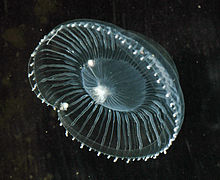| Thecate hydroids | |
|---|---|

| |
| Crystal Jelly (Aequorea victoria, Conica: Aequoreidae) with the parasitic amphipod Hyperia medusarum | |
| Scientific classification | |
| Domain: | Eukaryota |
| Kingdom: | Animalia |
| Phylum: | Cnidaria |
| Class: | Hydrozoa |
| Subclass: | Hydroidolina |
| Order: | Leptothecata Cornelius, 1992 |
| Synonyms | |
| |
Leptothecata, or thecate hydroids, are an order of hydrozoans in the phylum Cnidaria. Their closest living relatives are the athecate hydroids, which are similar enough to have always been considered closely related, and the very apomorphic Siphonophorae, which were placed outside the "Hydroida". Given that there are no firm rules for synonymy for high-ranked taxa, alternative names like Leptomedusa, Thecaphora or Thecata, with or without the ending emended to "-ae", are also often used for Leptothecata.[1]
In the sessile stage, Leptothecata are surrounded by a chitinous outer layer as their exoskeleton, including the gonophores, their reproductive organ. Leptothecata exhibit radial symmetry, and their gonads can be found in the radial canals of the medusa stage. Their habits range from benthic to planktonic. The polyps and colonial forms are benthic, whilst the medusae are planktonic. Leptothecata exhibit extensive, complex variation.[2] Thecata colonies also have extensive specialization due to their polyps' function and variation. Most Leptothecata possess statocysts, which are used for defence and protection. The classes that have lost their statocysts have been changed ancestrally over time rather than a direct loss.[3]

The approximately 1,900 species of Leptothecata are characterized by a number of features: Their polyps are always living in colonies with the hydranths set in hydrotheca which are usually permanent and often long enough so the animal can fully retract into it; some have very reduced hydrothecae resembling Anthoathecata. There is a single whorl of tentacles.
The gonophores are borne on much reduced hydranths and usually protected in a peridermal gonotheca. Medusae forming on fully developed hydranths are extremely rare; usually the gonophores develop into medusae or into sessile sporosacs. The medusae have a shallow bell, bear the gonads on their radial canals, and usually have statocysts which are formed only from epidermal tissue and more than four tentacles and. The cnidome never has stenoteles.